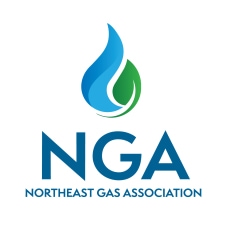Natural Gas & the Environment
Natural gas is a key part of the U.S. energy system, representing one-third of total energy consumed in 2020. It is a lower-carbon fuel than other fossil fuels, such as oil or coal, and has helped the U.S. achieve environmental progress in recent decades. However, as a fossil fuel, natural gas does contribute to carbon and methane emissions. The natural gas sector is working to lower its carbon output and be part of the needed solution to environmental challenges facing the U.S. and the globe. A review of some environmental trends regarding natural gas is provided in this summary.
Components of Natural Gas
Natural gas is composed primarily of methane. As described by U.S. EPA: "Natural gas is a fossil fuel formed when layers of buried plants and animals are exposed to intense heat and pressure over thousands of years. The energy that the plants and animals originally obtained from the sun is stored in the form of carbon in natural gas."
Natural gas has far fewer emissions of sulfur, nitrogen and carbon than other fossil fuels such as coal and oil. For instance, compared to coal, natural gas produces half as much carbon dioxide, less than a third as much nitrogen oxides, and virtually no sulfur oxides at the power plant.
Natural Gas and Power Generation
Natural gas has been the dominant fuel for new power generation in the Northeast for the last two decades, and one of the leading reasons has been its beneficial impact on air emissions. The U.S. EPA has noted that, "because of their relatively high efficiency and reliance on natural gas as the primary fuel, gas turbines emit substantially less carbon dioxide (CO2) per kilowatt-hour (kWh) generated than any other fossil technology in general commercial use."
Nationally, natural gas became the leading source of power generation, surpassing coal, starting around 2015. As in the Northeast, the rise of natural gas and the decline of more-polluting fuels, such as coal, has led to substantial air improvements; CO2 emissions have fallen by 32% over the last 15 years in the U.S. In June 2021, U.S. EIA noted that almost two-thirds of the decline in CO2 power sector emissions nationally between 2005 and 2019 is attributable to the shift from coal-fired to natural gas-fired electricity generation.
The electric utility sector in the Northeast has achieved major reductions in several air emission areas over the last 20 years-in great part thanks to new, more efficient power sources, from natural gas to renewables.
For example, in New York State over the last 20 years, NY ISO reports that emissions rates from the power sector dropped by 46% for CO2, 92% for NOx, and 99% for SO2. ISO-NE reports that since the year 2001, total emissions from power plants in New England have dropped by 99% for sulfur dioxide (SO2), 78% for nitrogen oxides (NOx), and 42% for CO2. PJM reports that over the last 15 years, between 2005 and 2021, CO2 emission rates fell 35% across its footprint, while nitrogen oxides declined by 85% and sulfur dioxide by 94%.
The chart below shows changes in carbon emissions by the electric power industry in the region, for the years 1990, 2000 and 2021, as an example of the progress that has been made in the region in reducing emissions.
Natural Gas Vehicles (NGVs)
The natural gas vehicle (NGV), also known as CNG vehicles (for compressed natural gas), has many environmental advantages. NGVs remain a competitive alternative to gasoline or diesel fuels,
particularly for certain key markets such as fleets and urban bus systems.
The U.S. Department of Energy's alternative fuel vehicle website notes: "Commercially available medium- and heavy-duty natural gas engines have demonstrated over 90% reductions of carbon
monoxide (CO) and particulate matter, and more than 50% reduction in nitrogen oxides (NOx) relative to commercial diesel engines."
According to NGV America, typical dedicated NGVs can reduce exhaust emissions of:
- Carbon monoxide (CO) by 70%
- Non-methane organic gas (NMOG) by 87%
- Nitrogen oxides (NOx) by 87%
- Carbon dioxide (CO2) by 20 to 30% below those of diesel and gasoline vehicles.
Reducing Methane Emissions within Gas System Operations
The natural gas industry is cognizant of its responsibility to reduce emissions from its system operations.
Many of NGA's distribution and transmission company members already participate in the U.S. EPA's "Natural Gas STAR" Program - progress continues on this front. For 2018 in the U.S., Natural Gas STAR partners reported methane emissions reduction of 130.6 Bcf, providing "cross-cutting benefits" according to EPA. Cumulative reductions nationally since the year 2004 total 1.6 Tcf.
Methane emissions related to U.S. natural gas systems have declined by 15.7% since 1990, according to the EPA's draft 2021 national GHG inventory report released in February 2023. The report notes: "Natural gas systems were the second largest anthropogenic source category of CH4 emissions in the United States in 2021, accounting for 181.4 MMT CO2 Eq. of CH4 (24.9 percent of total CH4 emissions). Emissions decreased by 33.7 MMT CO2 Eq. (15.7 percent) since 1990 largely due to decreases in emissions from distribution, transmission, and storage." [EPA, Draft Inventory of U.S. Greenhouse Gas Emissions and Sinks: 1990-2021, page ES-13]
For the distribution sector, the main emphasis has been on accelerating the replacement of older, more "leak-prone" pipe. EPA's draft 2021 GHG report indicates that methane emissions related to the nation's gas distribution system has declined by 70% since 1990 - reflecting tremendous progress in that sector.
As noted above, accelerated pipeline replacement of "leak-prone" system components, such as cast iron, is an industry and U.S. DOT priority
Shale Gas Production and the Environment
An environmental issue of interest concerns the development of shale gas resources in the U.S. The MIT study on natural gas from June 2011 notes that "the environmental impacts of shale
development are challenging but manageable."
In August 2011, an advisory group to the U.S. Energy Secretary released a series of consensus-based recommendations calling for increased measurement, public disclosure and a commitment to
continuous improvement in the development and environmental management of shale gas. Increased transparency and a focus on best practices "benefits all parties in shale gas production:
regulators will have more complete and accurate information, industry will achieve more efficient operations and the public will see continuous, measurable, improvement in shale gas
activities," the report says. The report calls for industry leadership in improving environmental performance, underpinned by strong regulations and rigorous enforcement, evolving to meet the
identified challenges. Further information can be found here: http://energy.gov/articles/secretary-energy-advisory-board-subcommittee-releases-shale-gas-recommendations
The Pennsylvania Department of Environmental Protection (DEP) in its 2017 Oil and Gas Annual Report released in August 2018, notes that: "Although there is no evidence that
hydraulic fracturing has resulted in a direct impact to a water supply in Pennsylvania, there are cases where related oil and gas activities have adversely affected private water supplies.
DEP investigates all stray gas-related complaints and if it is determined that a water supply is adversely affected by oil and gas activities, DEP works with the responsible operator to
ensure the water supply is restored or replaced."
The Pennsylvania Department of Environmental Protection (DEP) has comprehensive information on its regulatory role regarding shale gas production in that state; it can be found
here: http://www.dep.pa.gov/Business/Energy
/OilandGasPrograms/OilandGasMgmt/Marcellus-Shale/Pages/default.aspx#.Vo02NFJv8z1



